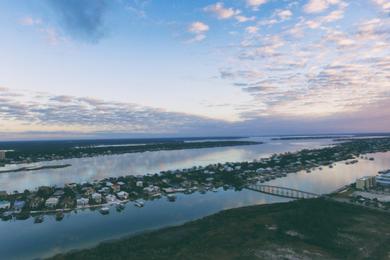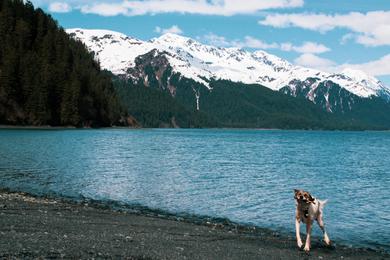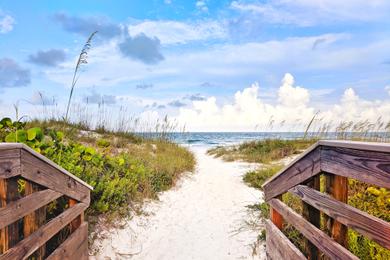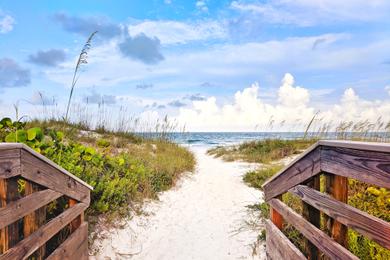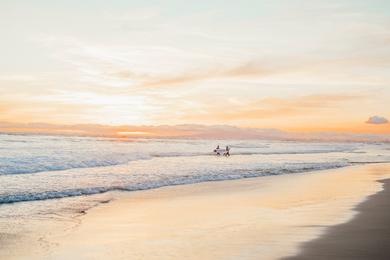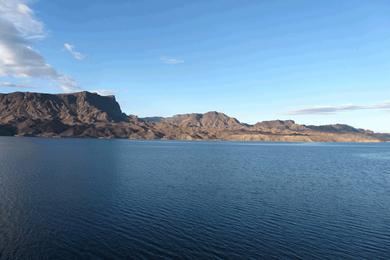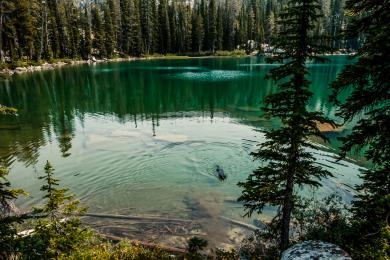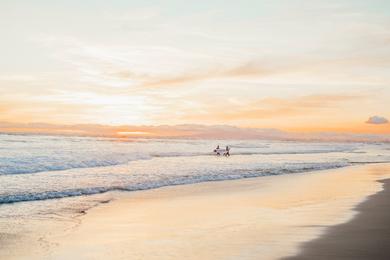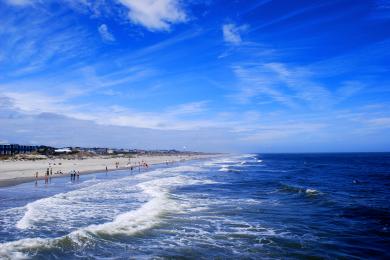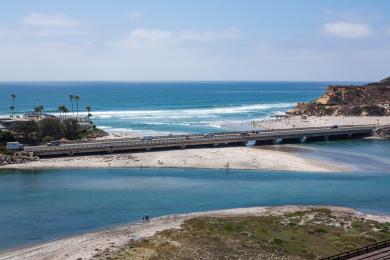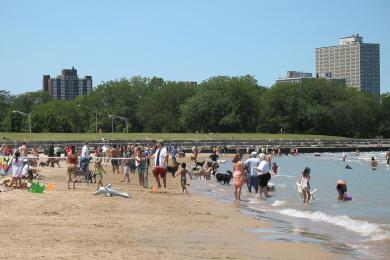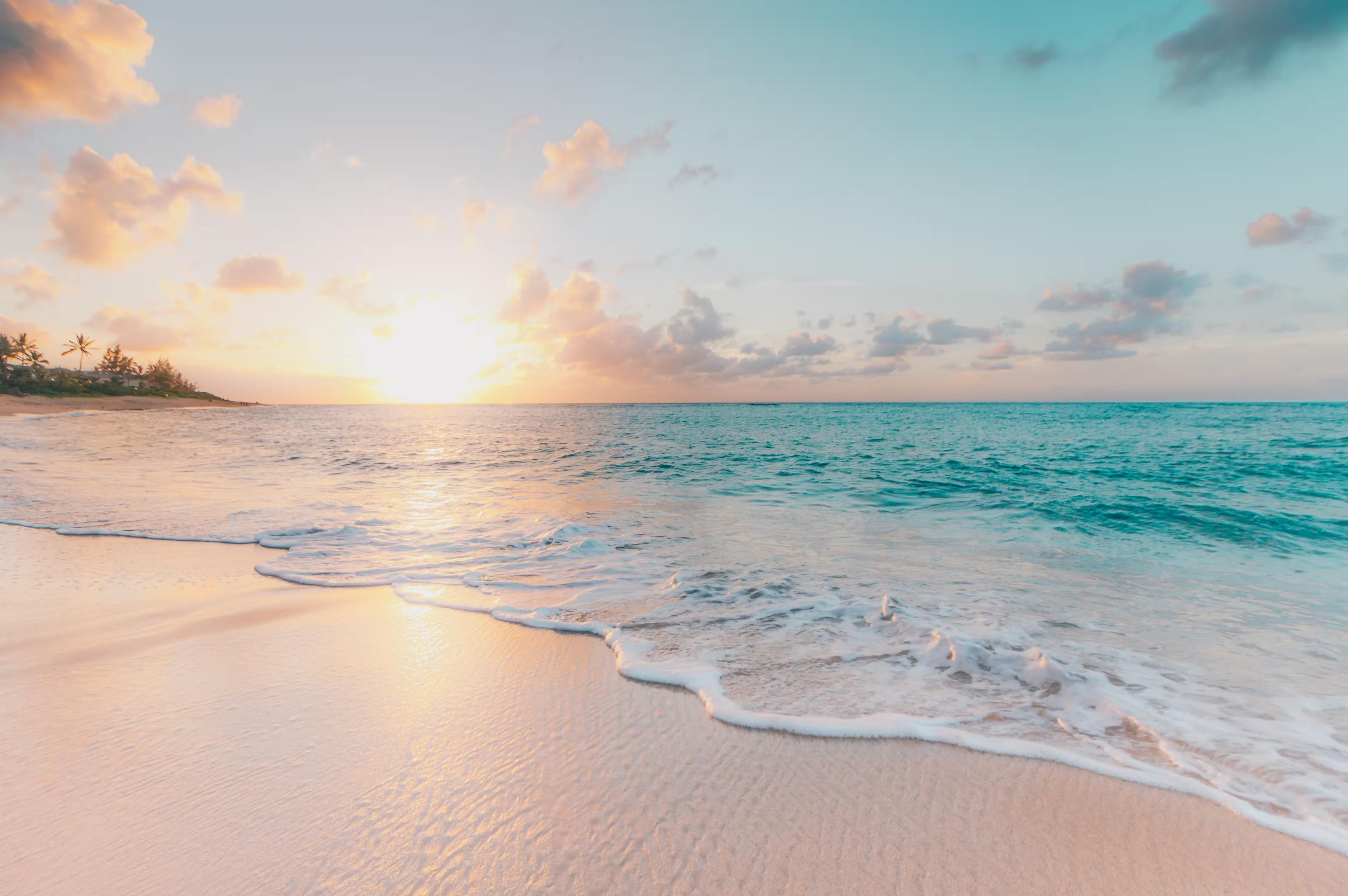Outrigger Canoe Club is an exclusive, private beach that comprises the final section of Waikiki Beach. The beach boasts a long history of prestigious water sport clubs, including surfing, beach volleyball, canoeing, and paddleboarding. The dining here rocks excellent as well – start with the well-known Duke’s that serves amazing seafood dishes near the beach. The amazing activities and restaurants are highlights, but the beach’s breathtaking sunsets make Outrigger Canoe Club a true Hawaiian paradise.
Read More...Paiko Lagoon is a serene and picturesque destination located in the eastern part of Honolulu, Hawaii. The lagoon is an artificial creation, built in the 1960s to protect the surrounding area from flooding. It is known for its tranquil turquoise waters and fine white sand, making it ideal for activities like swimming, kayaking, and stand-up paddleboarding. The nearby Paiko Wildlife Sanctuary adds to the area's natural beauty, providing a habitat for migratory birds and other wildlife. The beach is relatively small, about 500 feet long, and offers a peaceful atmosphere, often visited by families and those seeking a quiet retreat. The area is surrounded by residential neighborhoods, which contributes to its calm and uncrowded environment. While there are no hotels directly adjacent to the beach, nearby areas like Hawaii Kai and Waikiki offer a range of accommodations. The beach lacks lifeguards but is generally safe for swimmers due to its calm waters. Paiko Lagoon is a hidden gem for those looking to escape the hustle and bustle of city life, offering a serene backdrop for relaxation and outdoor activities.
Read More...Punaluu Beach Park is not located in Hauula, Hawaii, but rather on the Big Island of Hawaii. However, if we consider a similar beach in Hauula, it would typically offer a serene environment with lush greenery and scenic views. For the actual Punaluu Beach on the Big Island, it is renowned for its striking black sand, formed from basaltic lava, and is a habitat for endangered species like the Hawaiian green sea turtles. The beach provides a unique opportunity for wildlife spotting and offers a blend of natural beauty and historical significance. Visitors can enjoy activities like snorkeling, swimming, and picnicking, though strong currents may pose a risk during certain conditions. The beach is equipped with amenities such as restrooms, showers, and picnic pavilions. The area is rich in cultural heritage, with nearby historical sites and temples, making it a fascinating destination for those interested in history and nature.
Read More...Royal Moana Beach, located in the heart of Honolulu, Hawaii, offers a tranquil escape amidst the vibrant cityscape. This beach is a short walk from world-class Waikiki beaches and is surrounded by shops and restaurants, making it an ideal spot for both relaxation and entertainment. The area is known for its beautiful sunsets and proximity to iconic attractions like the Royal Hawaiian Center. Visitors can enjoy a variety of activities, from beach strolls to cultural events, while being close to the bustling Kalakaua Avenue. The beach itself is not as well-defined as other Waikiki beaches but offers easy access to the ocean and nearby amenities. It's a great spot for those looking to experience the local culture and enjoy the laid-back Hawaiian lifestyle. The surrounding area is rich in history, with landmarks like the Royal Hawaiian Hotel nearby, adding to the charm of the location.
Read More...Aukai Beach is a picturesque beach located in Hauula, Oahu, known for its soft, golden sand and serene atmosphere. It stretches approximately 1,200 feet, offering a tranquil setting for relaxation and leisure activities. The beach is part of a larger coastal area that includes other beaches like Mahakea and Kakela, providing a variety of spots for swimming, snorkeling, and sunbathing. The surrounding area is rich in natural beauty, with opportunities for hiking and exploring nearby attractions like the Polynesian Cultural Center. The beach's proximity to Hauula town allows visitors to enjoy local amenities, including dining and shopping options. It is a favorite among locals and tourists alike for its peaceful environment and accessibility to outdoor activities. During the winter months, visitors can spot humpback whales migrating through the area. Aukai Beach is part of Oahu's windward coast, which is generally cooler and wetter than the south and west shores, but still offers pleasant temperatures year-round. The trade winds provide a cooling effect, making it an ideal spot for those seeking a more laid-back beach experience.
Read More...Located in the northern part of Oahu, Hanakailio Beach - also called Hanaka‘ilio Beach - is a remote beach with light brown sand, some rocky portions, and a nearby small forest. This beach is situated on the shores of Hanakailio Bay. The rocky portions of Hanakailio Beach are composed of limestone.
Kahuku Golf Course, located on the North Shore of Oahu, Hawaii, is a charming 9-hole municipal golf course known for its oceanfront views and links-style layout. Built in the 1930s for the workers of Kahuku Sugar Mill, the course was later taken over by the City and County of Honolulu in 1952. Despite its rustic amenities, including port-a-potties and a lack of a 19th hole, the course offers a serene and challenging golf experience with strong trade winds and beautiful ocean vistas on eight of nine holes. The nearby Kahuku Beach, often referred to as Golf Course Beach, is a hidden gem with pristine white sand and limited facilities, offering an isolated retreat for those seeking a less crowded beach experience. The area is surrounded by lush scenery and exciting attractions like Turtle Bay Resort and the Polynesian Cultural Center. Visitors to the area can enjoy surfing, beachcombing, and dining at local eateries famous for seafood and traditional Hawaiian cuisine.
Read More...Kailua Beach, a long stretch of white, deep sand and baby-blue, cobalt-filled water, caters to everyone. For families, it's ideal because you can stay there all day. Its calm waters that are ideal for swimming, mild temperature, shade-filled areas, convenient on-site amenities and its picturesque scenery ensure that. For the more adventure-minded, the beach is one of the best in Hawaii for kitesurfing and windsurfing.
Read More...Laie Beach Park, also known as Pounders Beach, is a picturesque white-sand beach located on Oahu's northeastern shore. It is renowned for its year-round waves, making it a popular spot for surfers and bodyboarders. The beach features a shallow sandbar that creates a pounding shorebreak, especially during winter months. Visitors can enjoy swimming in calmer areas near the old pier pilings and explore the nearby 'bathtub beach,' which is protected by a coral reef. The beach is lined with ironwood trees providing ample shade for picnics. Laie Beach Park is close to Brigham Young University and the Polynesian Cultural Center, offering a mix of natural beauty and cultural attractions. The area is steeped in history, with names given by early Hawaiian inhabitants holding significant meaning. The beach offers a serene escape from more crowded areas like Honolulu, with plenty of nearby shops and restaurants in Laie. Laie is also home to a large Church of the Latter Day Saints community, which influences local activities and closures on Sundays.
Read More...Located in the north-western part of the Oahu shoreline, Makua Beach - also known as Mākua Beach, Pray For Sets Beach, and Pray For Sex Beach - is a large beach with light brown sand and some rocky portions, along with a few nearby trees. This beach is a part of a state park named Ka'ena Point State Park. The area near Makua Beach has towering mountains - these mountains are a part of the Waianae Mountain Range. The beach gets its alternative name (Pray For Sex Beach) from a “Pray 4 Sex” graffiti that is painted on a rock near the beach’s parking lot. “Pray 4 Sex” is a popular word-play on the high surfing activity in the water here - surfers here often “pray for sets” of good waves before entering the water here. Over time, the phrase “pray for sets” was distorted into “pray 4 sex.” Makua Beach was featured in the 1966 Gene Hackman, Julie Andrews, and Max Von Sydow movie Hawaii. The United States Armed Forces regularly conducts training sessions in the Makua Valley behind Makua Beach.
Located in the small town of Waianae, Manner’s Beach has a long and narrow beige-colored sand beach situated south of Black Rocks Beach Park. Manner’s Beach is adjacent to a marine conservation area that is home to many animals including tiny fish, black-and-yellow triggerfish, eels, and turtles making it popular for swimming and fishing during the summer season.
Niu Beach is a picturesque coastal neighborhood in East Oahu, located between Aina Haina Beach and the Kuliouou neighborhood. It is known for its intimate and relaxed atmosphere, with less than 100 homes, many of which are oceanfront properties. The area offers stunning ocean views and is close to several popular beaches, including Kawaikui Beach, Kuliouou Beach, and Maunalua Bay. Niu Beach is also historically significant, having been part of an ancient Hawaiian ahupua’a and once a summer home for King Kamehameha the Great. Today, it is a sought-after location for those seeking luxury living with easy access to ocean activities and a short commute to Honolulu's city center. The neighborhood is ideal for families and retirees alike, offering access to top-rated schools and a serene environment. Its proximity to Diamond Head and other cultural attractions makes it a unique blend of natural beauty and historical significance. Niu Beach Estate, a luxurious vacation rental, exemplifies the area's upscale living with its modern plantation style and breathtaking ocean views.
Read More...Baldwin Beach Park is a stunning beach located in Paia, Hawaii, known for its 1.2-mile stretch of soft, golden sand and picturesque views of the Pacific Ocean. The beach offers a serene atmosphere, perfect for sunbathing, swimming, and surfing. It is named after Henry Perrine Baldwin, a prominent figure in Hawaii's sugarcane industry. The surrounding area includes the charming town of Paia, known for its unique shops and local culture, and nearby attractions like Ho'okipa Beach Park for windsurfing and kiteboarding. Visitors can enjoy a variety of activities, including swimming, snorkeling, and picnicking. The beach features a protected swimming area known as Baby Beach, ideal for families and novice swimmers. Lifeguards are on duty to ensure safety, and amenities include restrooms, outdoor showers, and picnic areas. The beach is a popular spot for both locals and tourists, offering breathtaking sunsets and a tranquil environment. However, it is noted for being a clothing-optional beach, which may not be suitable for all visitors.
Read More...Located near the residential community of Hawaii Kai, Kuliouou Beach Park - also known as Kuli’ou’ou Beach Park - is a popular recreational park with a long and narrow beach with light brown sand and many nearby palm trees. This beach is known as Kuliouou Beach and Kuli’ou’ou Beach. Kuliouou Beach Park’s name means “sounding knee” in Hawaiian - this name is likely interpreted as a reference to piniu, which is a small Hawaiian drum that is tied to the knee and is used during local hula ceremonies.
Located in the town of Kailua, Lanikai Beach - also known as Kaʻōhao Beach - is a spectacular white sand beach on the island of Oahu. While many people claim that the beach’s name means "heavenly sea" in Hawaiian, it is an incorrect translation. It is often said that the beach's main name (Lanikai Beach) was invented by a real estate developer named Charles Frazier and the area around this beach was earlier known as Kaʻōhao to Native Hawaiians. This approximately half mile-long beach has an amazing backdrop of palm trees and oceanfront mountains. Lanikai Beach has been named one of the Top 100 beaches in the United States by Randall Kaplan, the world’s foremost beach expert who is known as Mr. Beach.
Laniloa Beach is a secluded gem located in Laie, Hawaii, known for its soft, golden sand and clear turquoise waters. This 300-yard-long beach offers a serene atmosphere, perfect for early morning beach walks and stunning sunrises. It is a popular spot for swimming and snorkeling, although it lacks extensive amenities like restrooms and lifeguards. The surrounding area is rich in cultural attractions, including the Polynesian Cultural Center and Laie Point State Wayside.The beach's tranquil setting makes it ideal for those seeking a peaceful retreat from bustling tourist areas. However, visitors should plan accordingly due to the limited facilities available.Despite its secluded nature, Laniloa Beach is a must-visit for anyone looking to experience the natural beauty of Oahu's North Shore.
Read More...Oneawa Beach, located in Kailua, Hawaii, is a serene and picturesque destination known for its tranquil atmosphere and beautiful scenery. The beach offers a peaceful retreat from the bustling city life, with its soft sand and calm waters making it ideal for relaxation and swimming. The surrounding area is rich in natural beauty, with lush greenery and scenic views that enhance the overall ambiance of the beach. Visitors can enjoy a variety of activities, including sunbathing, swimming, and picnicking, making it a perfect spot for both locals and tourists alike.Oneawa Beach is part of the larger Kailua Beach area, which is renowned for its stunning landscapes and diverse recreational opportunities. The beach is well-suited for family outings and offers a serene environment for those seeking a peaceful beach experience.Overall, Oneawa Beach provides a unique blend of natural beauty and tranquility, making it a must-visit destination for anyone looking to unwind in a stunning coastal setting.
Read More...Located in Honolulu’s Waikiki neighborhood, Fort DeRussy Beach is a wide 1,800-foot-long beach with light brown sand. This beach is a part of a waterfront recreational park named Fort DeRussy Beach Park and is also considered a part of a larger and very popular beach named Waikiki Beach. Fort DeRussy Beach comprises a quarter of Waikiki Beach, and the sand in the south-eastern part of the beach is finer than the sand in its other parts.
Fort DeRussy Beach Park has also been awarded the Fodor’s Choice award by the Fodor’s travel guide, and the park is usually open to the public between 5 am and 10 pm.
Kailua Beach, a long stretch of white, deep sand and baby-blue, cobalt-filled water, caters to everyone. For families, it's ideal because you can stay there all day. Its calm waters that are ideal for swimming, mild temperature, shade-filled areas, convenient on-site amenities and its picturesque scenery ensure that. For the more adventure-minded, the beach is one of the best in Hawaii for kitesurfing and windsurfing.
Read More...Located in the northwestern part of Oahu, Aweoweo Beach Park - also called Aweoweo Beach Park - is a recreational park which has a beach with light brown sand, a sloping incline, a nearby reef, and many nearby trees and shrubs. The shoreline around Aweoweo Beach Park is slightly rocky, and there’s a large drainage pipe here.
Located in the small town of Waimanalo, Kaupo Beach Park has a long, narrow, and rocky beige-colored sand beach situated in front of the Sea Life Park Hawaii. Kaupo in Hawaiian means ‘night landing’ and the park was named after a fishing village making it a great fising spot. Kaupo Beach Park is also known as Baby Makapu’u, Kumu Cove, and Cockroach Bay – and is popular among surfers, divers, and snorkelers. The beach at Kaupo Beach Park is onshore from two small islands – Rabbit Island and Kaohika’ipu which are seabird sanctuaries and you must have a permit to visit here.
Located in the town of Mokulēia, Mokuleia Beach Park - also called Mokule'ia Beach Park - is a recreational park that has a long and narrow beach with light brown sand and many nearby trees, shrubs, grass, and a nearby reef. This beach is also called Mokuleia Beach and a portion of this beach is named Army Beach, and it is located near an airfield namedKawaihapai Airfield which was formerly named Dillingham Airfield. As an interesting fact, this park was the filming location for a portion of the TV series Lost. The name of the park - Mokuleia - means “district of abundance” in Hawaiian.
Located
in Honolulu, Gray’s Beach - also known as Grays
Beach, Halekulani Beach, Kawehewehe, and Grey’s Beach - is an extremely narrow light-brown sand beach with
nearby trees. This beach is located in
front of an upscale hotel called the Halekulani Hotel. Gray’s Beach is a part of a larger beach area
named Waikiki Beach. This beach has been severely reduced in size
due to constant erosion by ocean water.
A sea wall located near the beach has further accelerated this
decline. This beach received its name
(Gray’s Beach) because a boarding house named Gray’s-by-the-Sea was present
near the beach in the early 20th century - this house was run by a woman named
Mrs. LaVancha Gray. The beach’s Hawaiian
name (Kawehewehe) means “removal” - this beach received this
name because the water near it was thought to have supernatural healing
powers. In the past many sick members of
the Hawaiian nobility came to bathe in the water here - apart from bathing,
they would also offer a seaweed lei to the water here as a way of seeking
forgiveness for past sins. This ritual
was known as a cure for many illnesses.
The water near Gray’s Beach also has a coral reef and a sand-filled
aquatic channel.
Kuilima Cove is a serene and picturesque beach located on Oahu's North Shore, adjacent to the Turtle Bay Resort. It is nestled in a protected cove, making it an ideal spot for swimming and snorkeling in calm conditions. The beach offers stunning golden sands and crystal-clear waters, teeming with diverse marine life like sea turtles and colorful fish. Its proximity to the resort provides easy access to amenities like restrooms, showers, and picnic areas. The cove also offers breathtaking views and is a popular spot for family gatherings and relaxation.
Kuilima Cove has historical significance, named after a traditional Hawaiian altar once located on its western point. Residents have also referred to it as Kalokoiki, or 'the little pool.' This tranquil setting offers a perfect immersion into Hawaii's natural beauty and cultural heritage.
The beach is accessible via a public parking lot at the Turtle Bay Resort, making it convenient for visitors. However, it can get crowded due to its popularity among tourist groups. Despite the crowds, the surroundings remain peaceful and scenic, making it a must-visit destination for beach lovers.
Read More...Kahala Beach is the Hawaiian paradise that you’ve always dreamed of. You might expect that this tropical oasis is often crowded, as its bright blue waters and golden sands are particularly inviting and the beaches of Oahu are among the most sought-after destinations in the world. Yet, Kahala Beach defies all norms. This isolated, tranquil beach is an uncrowded, sandy beach that’s lined with swaying palm trees, and is only a 20-minute drive from the center of Waikiki.
Getting to Kahala Beach is easy - the multiple access paths to the beach are located along Kahala Avenue, near its intersections with Elepaio Street, Kala Place, Hunakai Street, and Koloa Street. It is also important to note that Kahala Beach’s access path near the intersection between Kahala Avenue and Kala Place also has two lion statues near it. There are free street parking spaces along some of the roads which intersect Kahala Avenue - one of these roads which have street parking spaces is the Kala Place. It is important to note that the access paths for Kahala Beach near Elepaio Street and Kala Place lead to portions of the beach which are narrow with very little sand.
Once you’ve reached the beach, the lagoon-like water filled with vibrant coral and sea life makes for an ideal snorkeling hotspot. You’ll often see sailboats and kitesurfers along the waters as well. Sometimes there are even a few destination weddings right on the sand! If you venture west along the beach, you’ll pass the Waialae Country Club and its beautiful 18-hole ocean-view golf course, nestled among gated $10-$20 million homes. Situated beyond the club, you’ll find Wai’alea Beach Park, which has an expansive lawn and a stream that runs out to the ocean; you’ll also find a public bathroom and a shower. If you’re looking for accommodations here, Kahala Hotel and Resort is a great place to stay – it has a dolphin pool, spa and fitness center, complimentary water sports equipment, and great beach access. The hotel also offers and array of dining options – including Arancino at The Kahala, Hoku's Restaurant, the Seaside Grill, and the Kahala Hotel Beach Side Buffet. We also love the Plumeria Beach House, a casual, open-air restaurant near the lobby of the hotel. Whether you’re staying for a day, a week, or a month, you’re going to love your time at Kahala Beach.
Kealia Beach, located on the East Coast of Kauai, is a stunning stretch of golden sand and clear blue waters. It is a favorite among locals and visitors alike for its serene atmosphere and diverse activities such as swimming, surfing, and long beach walks. The beach is connected to a scenic coastal path, perfect for biking and jogging, and offers picnic areas and amenities like restrooms and showers. Lifeguards are present to ensure safety during peak hours. Kealia Beach is also known for its historical significance, as it was once used for salt gathering by Native Hawaiians. The name 'Kealia' translates to 'the salt bed' or 'salt-encrusted area.' The beach provides a peaceful escape from crowded tourist spots and is ideal for those seeking relaxation or adventure. Visitors can enjoy the beautiful sunrises and sunsets, and the beach is less crowded than other popular spots in Kauai. It offers a picturesque setting for photography, with its wide horizons and turquoise waters. Kealia Beach is also a great spot for whale watching during the winter months. The beach's natural beauty and recreational opportunities make it a must-visit destination on Kauai's Coconut Coast.
Read More...Located in the small town of Waialua, Puuiki Beach Park has a long and narrow beach situated south of Kahawai Beach Support Park. Spread across 40 acres, Puuiki Beach Park is adjacent to a marine conservation area and is home to many animals including tiny fish, black-and-yellow eels, and turtles. This makes it a very popular swimming, surfing, snorkeling, and fishing destination during the summer season.
Kaihalulu Beach, also known as Red Sand Beach, is a secluded and breathtakingly scenic destination located south of Hana Bay in Maui, Hawaii. This beach is renowned for its vibrant red sand, which contrasts dramatically with the lush green cliffs and azure waters. The beach is sheltered by a lava rock wall, creating a calm environment ideal for swimming and snorkeling when the water is calm. However, it is known for being a clothing-optional beach due to its secluded nature. The beach offers a tranquil escape and unparalleled scenery, making it a must-visit for adventurous travelers and nature lovers alike.Accessing Kaihalulu Beach requires a short but challenging hike, which adds to its adventurous appeal. The trail can be treacherous, especially when wet, so caution is advised. The beach's unique features and scenic backdrop make it perfect for photography and relaxation.Despite its remote location, Kaihalulu Beach is a gem that offers a unique experience off the beaten path. Visitors should be prepared with essentials like food, water, and sturdy shoes, as there are no facilities at the beach.
Read More...Ewa Beach, situated on Oahu's southwest coast, is a captivating seaside community known for its pristine beaches and rich cultural heritage. It offers a variety of recreational activities, combining natural beauty with a strong sense of history and community. The area is home to beautiful beaches like White Plains Beach, ideal for surfing and relaxation, and Ewa Beach Park, which provides a peaceful setting for picnics and local events Located about 20 miles west of Honolulu, Ewa Beach features a year-round warm climate with minimal rainfall, making it perfect for outdoor activities. The local culture is vibrant, with influences from Native Hawaiian traditions and historical plantation sites. It is also a growing town with new developments, offering modern amenities and services. This scenic area provides opportunities for snorkeling, paddleboarding, and exploring marine life, making it a great destination for nature enthusiasts and adventure seekers.
Read More...Located less than three miles away from the famous Waikiki District in Honolulu, Makalei Beach Park carries the Hawaiian name for “Peacock”, perfectly representing its lush turquoise waters. Getting to this beach requires a ten minute hike down Diamondhead Road, where you can observe the diverse fauna of O’ahu before arriving at this small and secluded beach surrounded by residential properties. This beach park sports clean tables and benches, making it the perfect place for a lunch picnic on the sand. It also accommodates dogs and has a small bathroom facility, which adds to its family-friendly atmosphere.
The highlight of this beach is its crystal clear turquoise waters. Its gentle nature invites snorkelers and divers to explore the nearby coral reefs and welcomes beginner surfers to try out the waves. According to locals, there is a family of monk seals that loves to wade in the waters! If you want to enjoy the soft white sand, be sure to avoid high tide, as the water fills all the way up to shore. Even so, there is an elevated grass area with plenty of shaded areas that are always available for those looking for a place to sit.
If you get hungry, you can take a short ten-minute walk to Michel’s at the Colony Surf, a classic French restaurant that offers extensive fine seafood dining and is known for their lobster bisque. If you want a more affordable bite, check out the BBQ options at Barefoot Beach Cafe, which is known for its vibrant atmosphere highlighted by live music on weekends. Don’t miss out on South Shore Grill, a family-owned restaurant that boasts the best fish tacos in Honolulu.
If you need a place to stay, check out the Lotus Honolulu at Diamond Head, located half a mile from Makalei. This four-star hotel boasts ocean views and offers amenities such as wine-tasting events and bike rentals, providing options for everyone in the family. If you are looking for a more affordable room, the Waikiki Grand Hotel is just a five minute drive from the beach. This casual hotel offers free Wifi, an outdoor pool, and a night club that attracts locals and tourists alike. Lastly, the Pacific Monarch Hotel is a fifteen minute drive from the beach and is located in the heart of the Waikiki District. This all-suite hotel has a beautiful rooftop pool and is right next to the Honolulu Zoo, which serves as an excellent day-trip site for families with young children.
Turtle Bay Beach is located on the North Shore of Oahu, Hawaii, known for its stunning natural beauty and diverse wildlife. The beach offers a mile of golden sand and is surrounded by jagged cliffs with lush green vegetation. It is a popular spot for outdoor activities like swimming, snorkeling, and surfing. The nearby Turtle Bay Resort provides luxurious accommodations and amenities, making it an ideal destination for both relaxation and adventure. The bay is home to green sea turtles and offers breathtaking views of the ocean. Visitors can enjoy the tranquil atmosphere and engage in various water sports. The area is also famous for its film and television appearances, including scenes from *Lost* and *Forgetting Sarah Marshall*. With its unique blend of natural beauty and modern amenities, Turtle Bay Beach is a must-visit destination for anyone traveling to Oahu.
Read More...Located near Honolulu, Kaalawai Beach - also called Cromwell’s Beach, Ka’alawai Beach, and Cromwell’s - is a narrow beach with light brown sand, some rocky portions, a nearby seawall, a nearby coral reef, and many nearby palm trees and shrubs in the island of Oahu. The beach is situated near an upscale residential area. The name of the beach - Kaalawai - means “the watery rock” in Hawaiian - the beach received this name because underwater freshwater deposits occasionally bubble up to the ocean surface around the reefs near the beach. This beach received its alternative name - Cromwell’s Beach - because the area around it was earlier a yacht dock for American diplomat and United States Senatorial candidate James H.R. Crowell, who was the husband of renowned American socialite and philanthropist Doris Duke - Duke earlier owned an estate near the beach, which was called the “Shangri La.” Duke’s house is currently the site of a museum named The Shangri La Museum of Islamic Art, Culture & Design.
